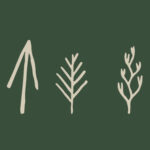Summer seed collections
This summer, staff at the Dundreggan nursery have been busy collecting seed for storage at the Millennium Seed Bank. The Millennium Seed Bank is growing a collection of seeds from around the world, aiming to provide a safety net for species at risk of extinction.
Three collections have been made this year: gathering aspen; goat willow; and grey willow seeds.
Aspen is a rare tree in the Caledonian Forest, and one of the native trees that we specialise in at our nursery. Our aspen project has been running since 1991 and anyone who visits the nursery will see that we are aspen enthusiasts! However, aspen is one of the most difficult trees to get seed from in the North-West Highlands.
Aspen grows and expands its range by producing young trees from its roots (known as suckers) and by producing seed. Aspen are dioecious meaning the trees are either male or female. In order to produce seed, trees of both sex need to be in close proximity. However, due to deforestation and the grazing of aspen by deer, we are left with aspen stands that are low in number, and far apart. This distance between aspen stands makes wind pollination difficult.
Also, aspen trees in the North-West Highlands go for long periods of time between flowering. It is thought that flowering occurs after a hot and dry summer the previous year, not something the North-West Highlands are known for.
And finally, the male flowers develop first, overlapping with the female flowers for a very short time. Leaving only a small window for pollination to occur.
It seemed the odds were well and truly stacked against us for this collection.
However, 2019 was to be our lucky year. After an uncharacteristically hot summer in 2018, we were waiting with baited breath to see if the aspen would flower. Not only did they flower, but it was the biggest mass-flowering of aspen in Scotland for nearly 30 years.
Abigail, nursery supervisor, and our friends at Coille Alba, did an amazing job of searching the glens high and low for flowering aspen trees, collecting flowering branches to bring them back to the nursery. What resulted was a fantastic collection of both female and male flowers that we kept on the nursery. We harvested pollen from the male flowers, and waited for the female flowers to develop before hand-pollinating them.
We then waited to see if the female flowers would set seed, and they did. After harvesting and processing the seed we were able to send 3.5g of aspen seed to the Millennium Seed Bank – about half a teaspoon. It might not sound like a lot, but aspen seed is extremely small. After going through quality control and germination tests in their labs, we are delighted to report that within half a teaspoon of seed there was an estimated 22,630 seeds which are now safely stored in liquid nitrogen at -190c!

